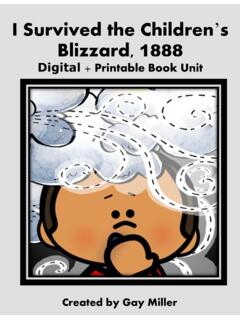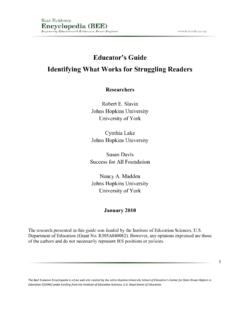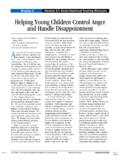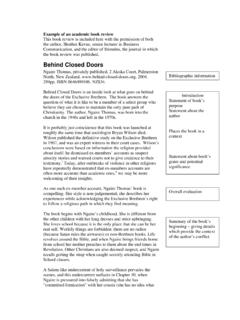Transcription of Teacher’s Guide - picturebookmonth.com
1 Teacher s Guide Why Picture Books Belong in Our Classrooms Packed with engaging ideas and activities to bring picture books into the ELA, Math, Science, and Social Studies curriculum! Complete with information on aligning lessons to the CCSS for ELA and Math and other state-mandated learning standards. Permission granted to copy and share for educational uses. The Teacher s Guide for Picture book Month copyright 2013 Marcie Colleen. Learn more at: and Picture book Month logo by Joyce Wan Become a Picture book Month Ambassador. Register at & join the celebration! 1 What is Picture book Month? Picture book Month is an international literacy initiative that celebrates print picture books during the month of November. Founder, Dianne de Las Casas (author & storyteller) , and Co-Founders, Katie Davis (author/illustrator) , Elizabeth O.
2 Dulemba (author/illustrator) , Tara Lazar (author) , and Wendy Martin (author/illustrator) , put together their worldwide connections to make this happen. Every day in November, there is a new post from a picture book champion explaining why he/she thinks picture books are important. In this digital age where people are predicting the coming death of print books, picture books (the print kind) have so much to offer that they must be celebrated and shared. And the world needs picture books. There s nothing like the physical page turn of a beautifully crafted picture book . What You Can Do to Celebrate Picture book Month? * Become a Picture book Month Ambassador and place the Ambassador badge on your website, with a link to * Register at so that you can pledge to celebrate your love of picture books throughout the month of November.
3 You will also be added to the Picture book Month mailing list. * Create posters and hang them around your school and library. Posters are available for download online in the media kit. Be sure to include the book covers of your favorite picture books. * Download the theme calendar for Picture book Month to help you create a month-long celebration of picture books. * Count how many picture books are checked out and keep a running total. At the end of the month, let us know how many your school or library read! * Tweet the cause and/or reviews of your favorite picture books. Use the hashtag #picturebookmonth * Get the Picture book Month Twibbon, a digital ribbon that can be added to your Twitter avatar or Facebook profile picture. Details online.
4 * Ask a picture book author/illustrator to visit or do a Skype visit to your school or library. * Post a review of your favorite picture book to , Goodreads, Library Thing, or your blog. * Follow Picture book Month (@picturebkmonth) and founder Dianne de Las Casas (@AuthorDianneDLC) on Twitter for updates every day in November. You can find Picture book Month on Facebook, too. November is Picture book Month. Read * Share * Celebrate! 2 Table of Contents The Heart of Learning: Why Picture Books Belong in Our Classrooms 3 English Language Arts 4 Teacher Testimonial: Picture Books as Mentor Texts for Writing 6 Math 7 Science 9 Teacher Testimonial: Two Teachers, Countless Possibilities 11 Social Studies 12 Helpful Resources 14 Share Your Ideas 15 How To Use This Guide This teacher s Guide for Picture book Month is designed to help teachers integrate picture books into English language arts (ELA), mathematics, science, and social studies curricula.
5 Art and drama are encouraged throughout the Guide and all activities were created in conjunction with relevant content standards in ELA, math, science, and social studies. 3 The Heart of Learning: Why Picture Books Belong in Our Classrooms With the rise of bullying in our schools, how can we deny that our classrooms need more heart? The danger is that with the implementation of mandated learning standards, teachers feel forced to spend more time teaching to the test, in lieu of teaching matters of the heart or worse yet, teaching with their hearts. Picture books can address both heart and the standards. Picture books allow for story. Picture books teach empathy. Picture books help relate human experiences to academic concepts and address complex issues and content.
6 And because picture books have a short focused format, the academic concepts and complex issues become readily accessible to children. This Guide is not meant to be an instruction book on what exactly to do to bring picture books into your classroom. Instead it serves as a celebration and call-to-action to springboard your own ideas for using picture books in your classroom. By focusing on the academic concepts deemed necessary by state and federal mandated learning standards, this Guide sets out to empower teachers to consider picture books as valuable resources, which connect students with content and inspire their humanity. Any picture book can be tied into the CCSS and other state standards. Therefore, teachers should feel authorized to choose the texts they want to teach and find alignment from there, not the other way around.
7 Lately, non-fiction picture books have been getting a lot of attention and although non-fiction picture books provide wonderful content for inclusion within the classroom, it is my wish that fiction picture books would be given the same attention and opportunity to thrive within the academic environment. My hope is that this Guide provides inspiration, validation, and celebration for all picture books in every classroom. Marcie Colleen, Picture book Month s Education Consultant, has been in education for 18 years. She is a former New York classroom teacher and has served as a curriculum creator for the Central New York Institute of Aesthetic Education, Syracuse Stage, Tony Randall s National Actors Theater, and various Broadway and Off-Broadway shows.
8 She was the Director of Education for TADA! Youth Theater in NYC creating and managing educational programming reaching over 30,000 students and families in the NYC Metro area a year. Her Teacher s Guides for picture books and middle grade novels can be found at 4 English Language Arts Why Picture Books? Picture books are wonderful tools for teaching story structure, key ideas, and details because of their simple linear plot lines and setting, with a few highly developed characters. Picture books prompt a variety of creative writing assignments. Picture books lend themselves nicely to technical writing assigments, including but not limited to letters to authors or illustrators, book reviews, research papers based on a theme found within the story.
9 Picture books are specifically and technically crafted. Due to the concise and simple nature of the genre, word choice and structure is extremely important. Picture books are meant to be read-aloud, which automatically makes them a social experience. The very nature of reading a picture book invites conversation and questions that support students developing understandings of language and their world. Picture books contain many literary conventions including but not limited to, rhyme, onomatopoeia, alliteration, hyperbole. Visuals in the illustrations build skills for determining meaning through context. Classroom Activities: How I See It ~ Choose a character, other than the main protagonist, and write the story from their Point of View.
10 Use The True Story of the 3 Little Pigs as told by Jon Scieszka and illustrated by Lane Smith, as an example. For another challenge, the students could place themselves in the story and tell their own version. Reader s Theater ~ Create a Reader s Theater version of the story. Cast students as the characters and have them read the book s dialogue or develop their own lines to best re-tell the story. Based on the Common Core State Standards for English Language Arts & Literacy in History/Social Studies, Science and Technical Subjects and the National Council of Teachers of English and the International Reading Association Standards for the English Language Arts. Concepts: * Reading * Writing * Speaking & Listening *Language 5 Diaries, Letters, Journals, and Messages ~ These creative writing assignments require students to use appropriate vocabulary, point of view, content and form, as well as enable students to experiment with different purposes for writing.








